
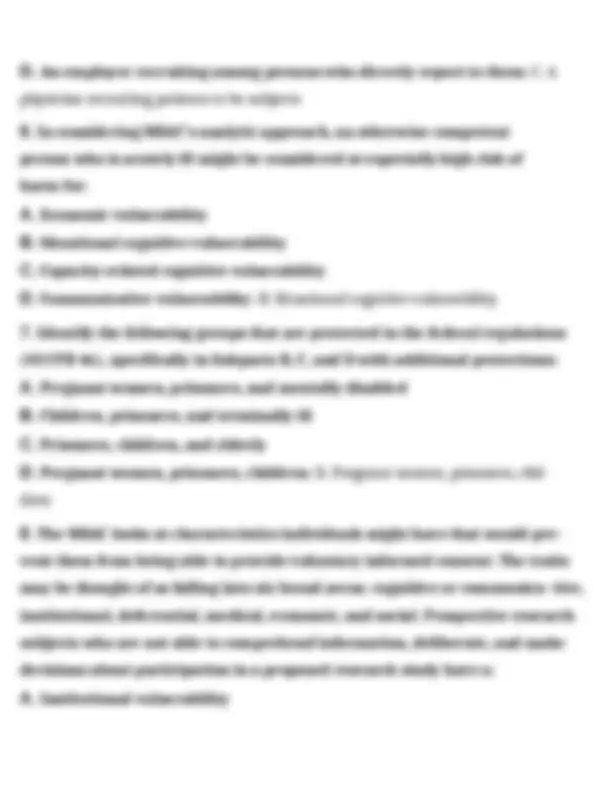
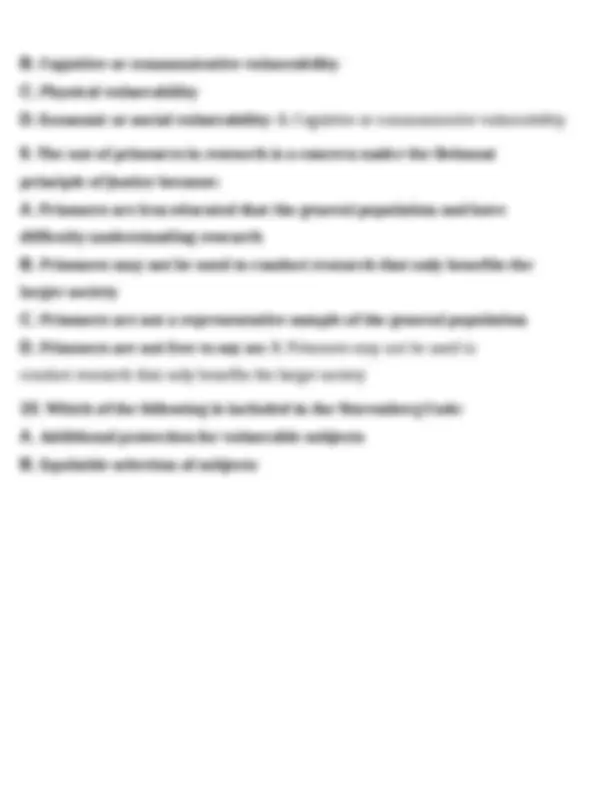
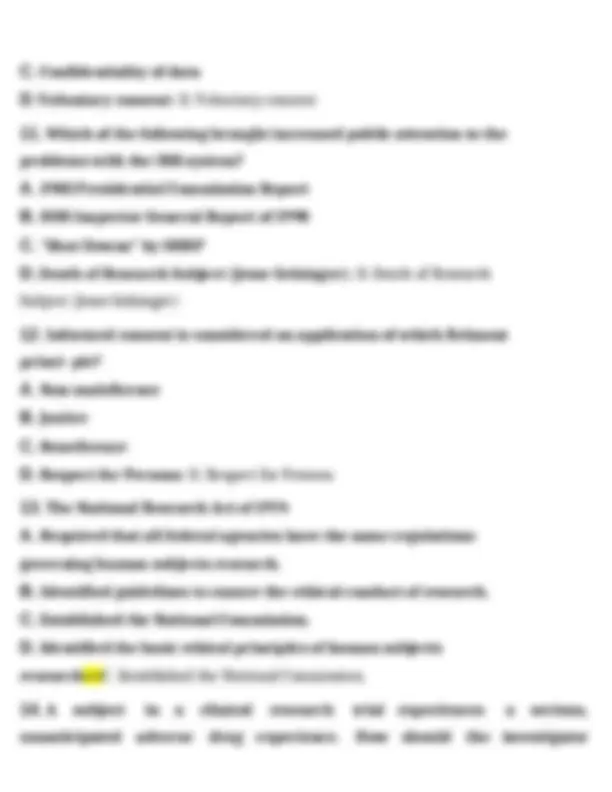
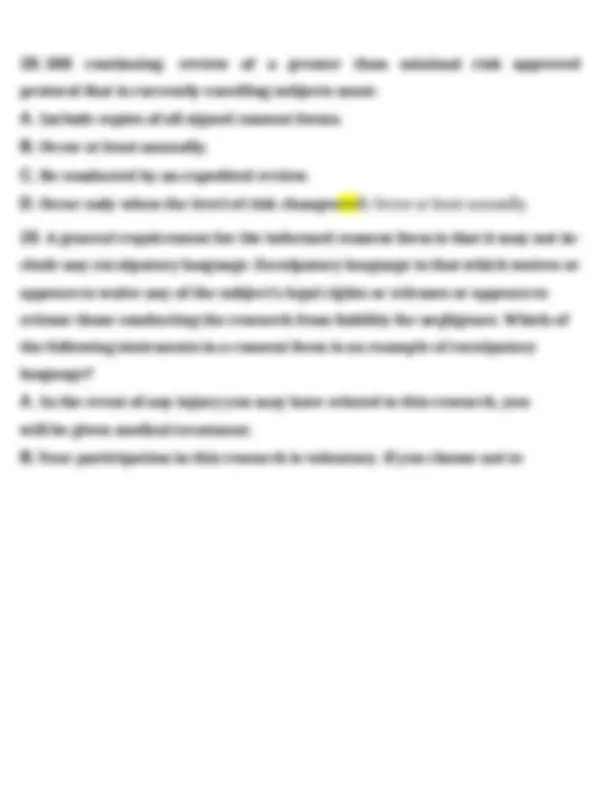
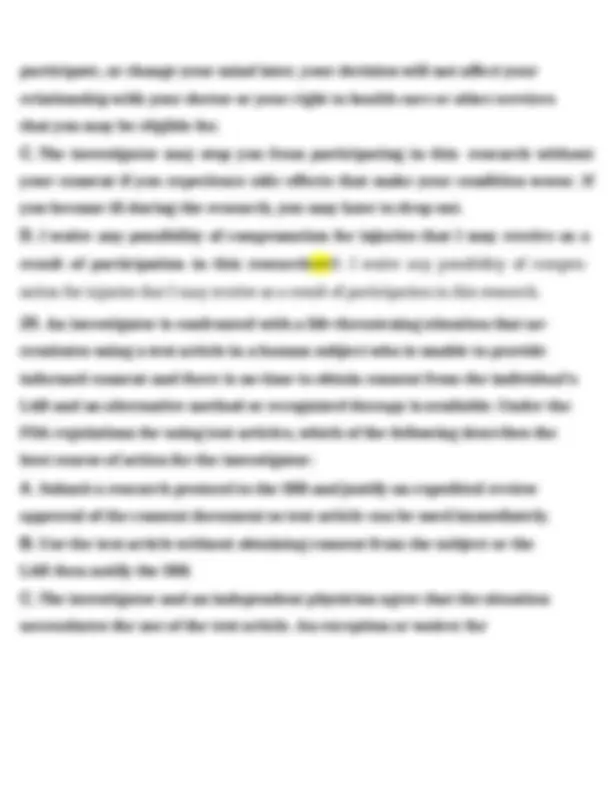
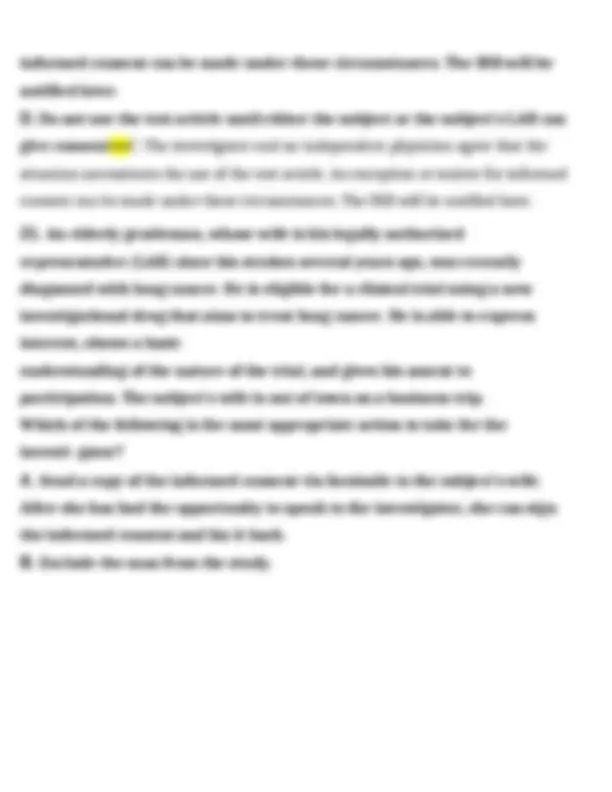
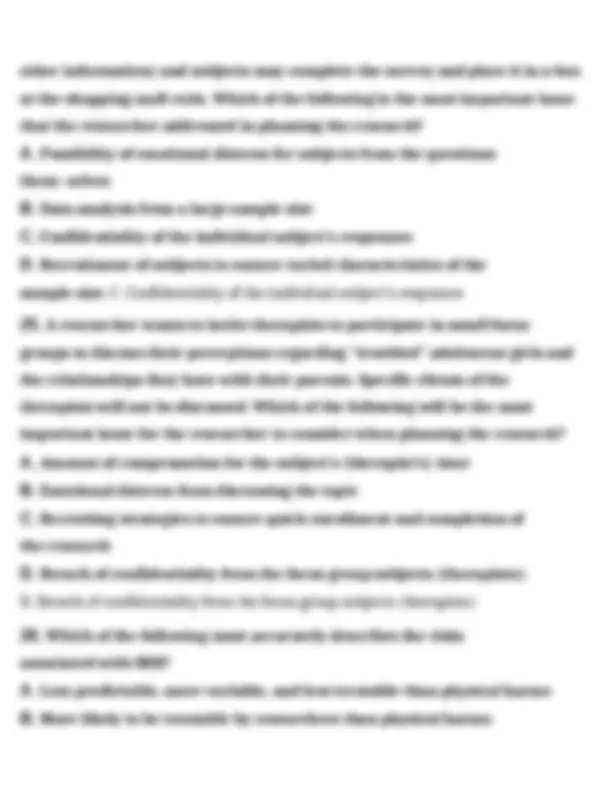
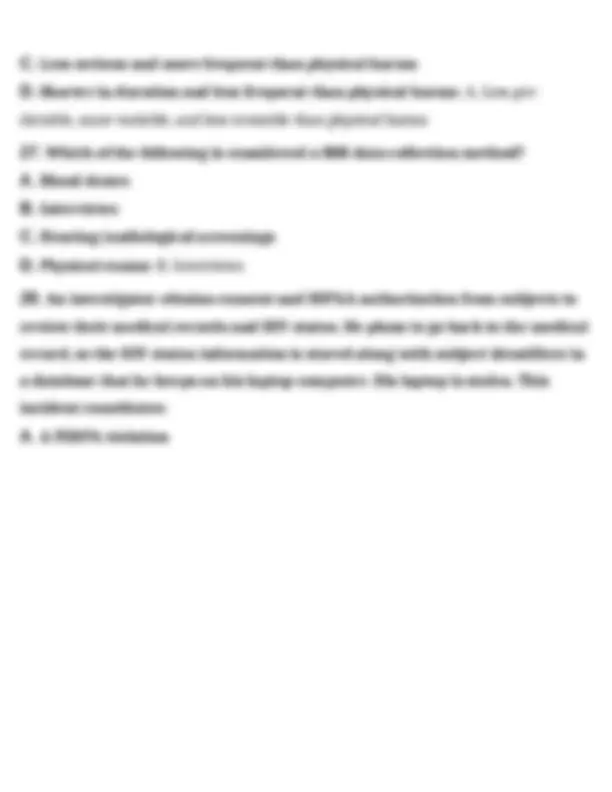
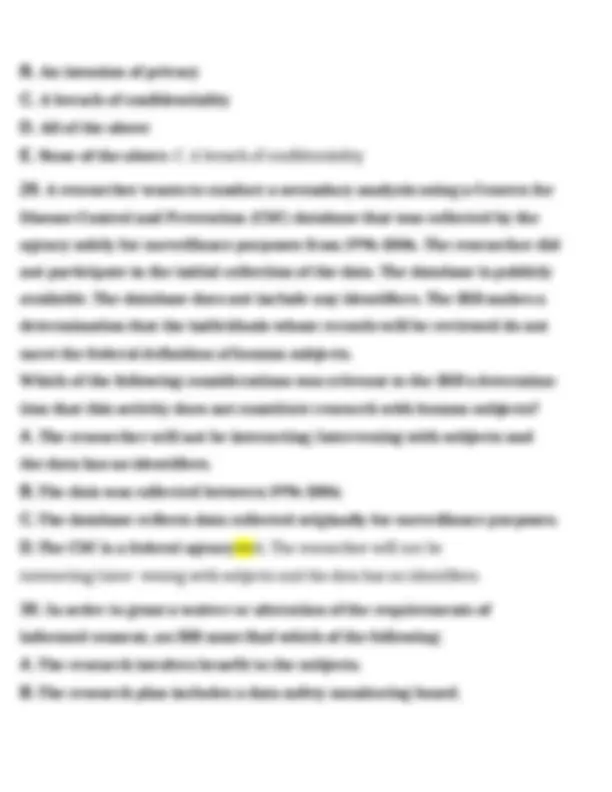
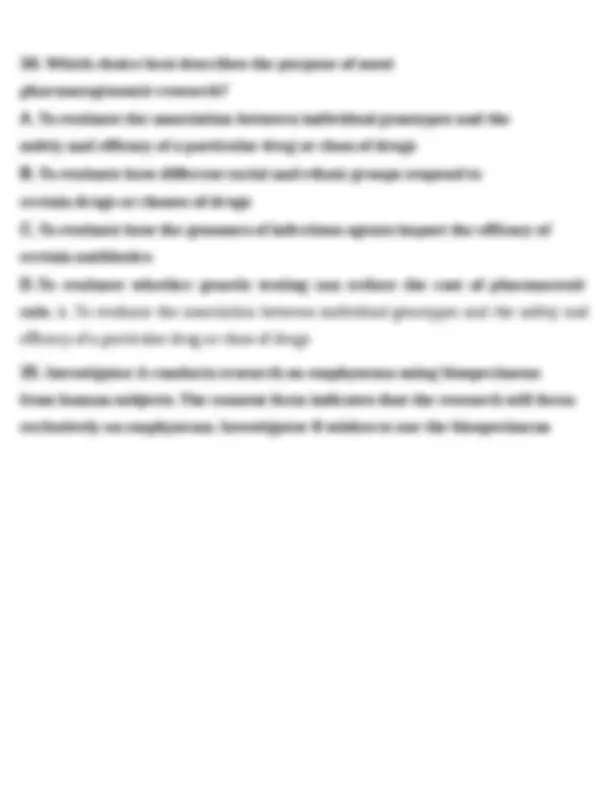
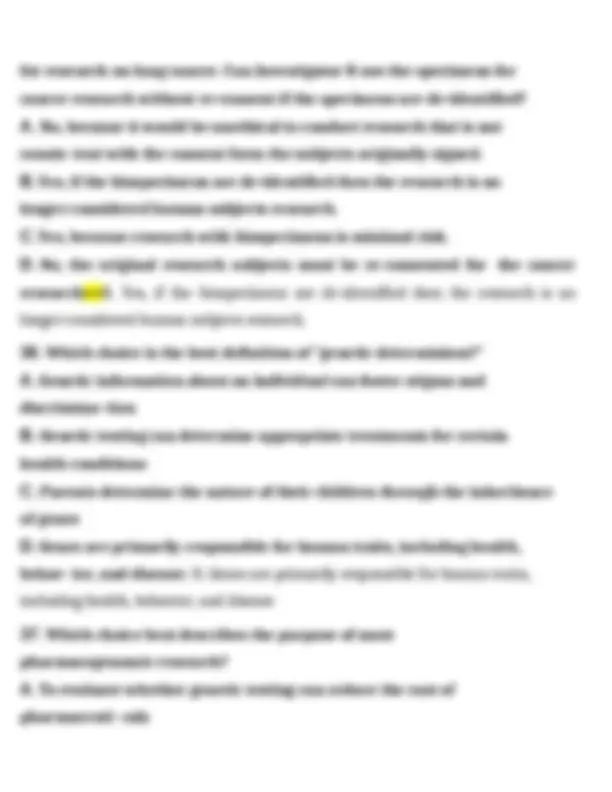
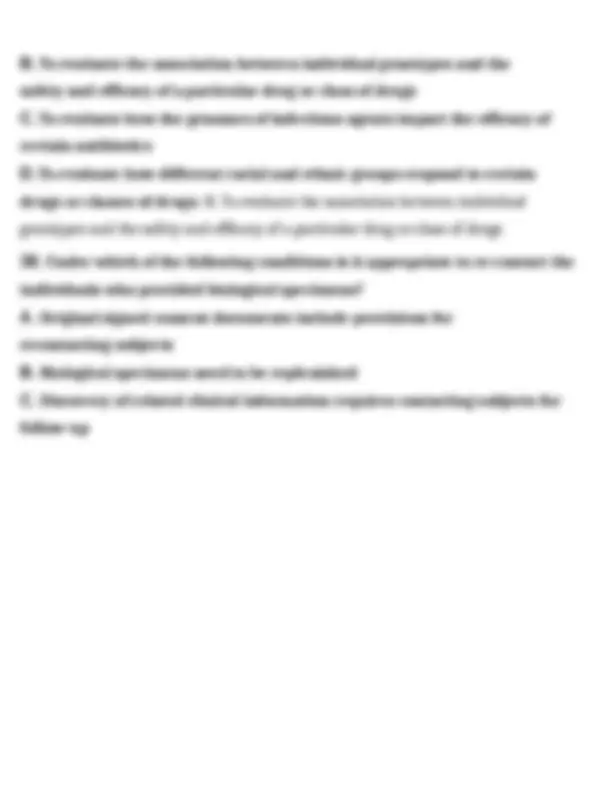
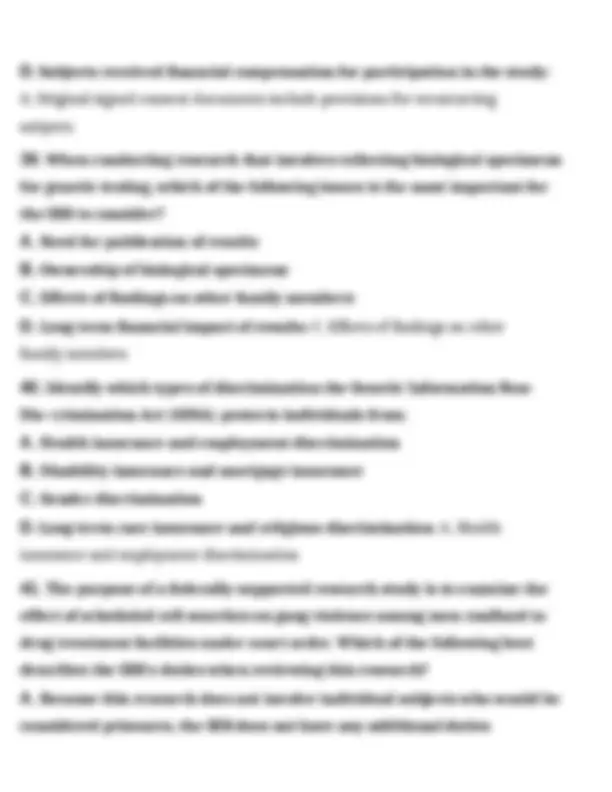
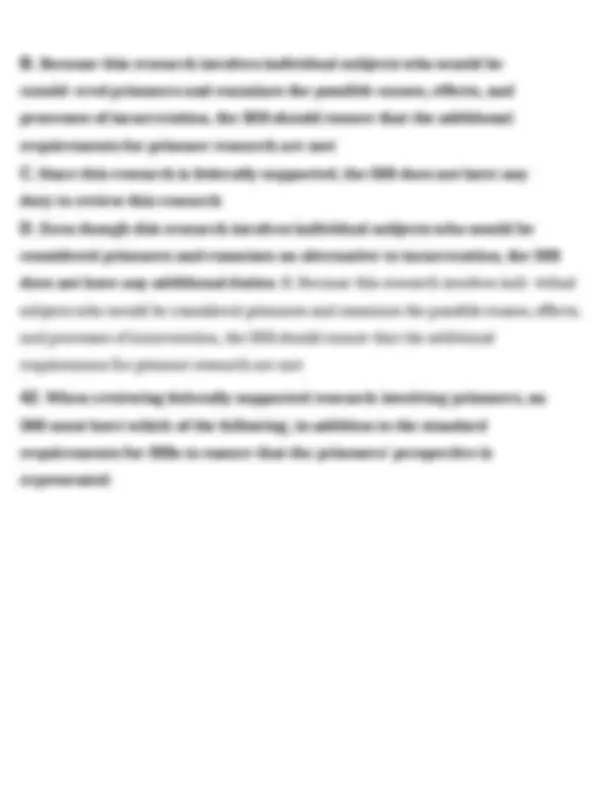
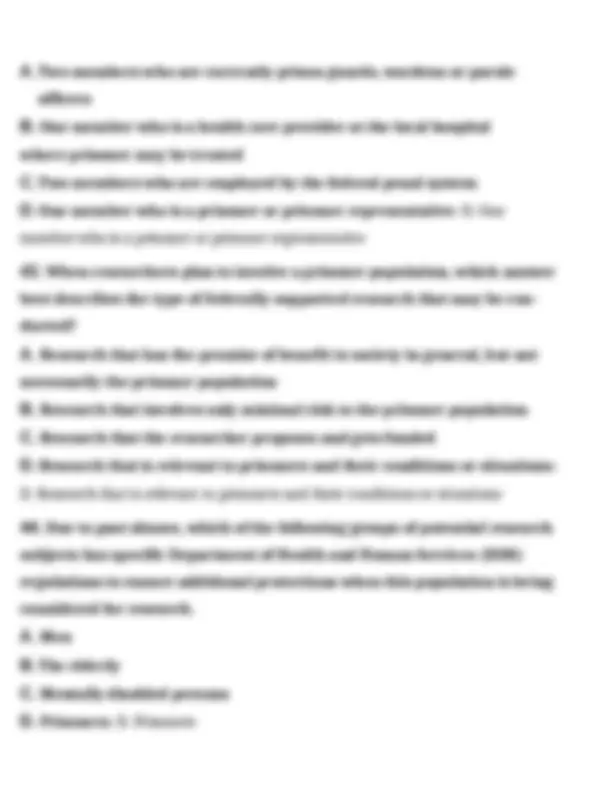
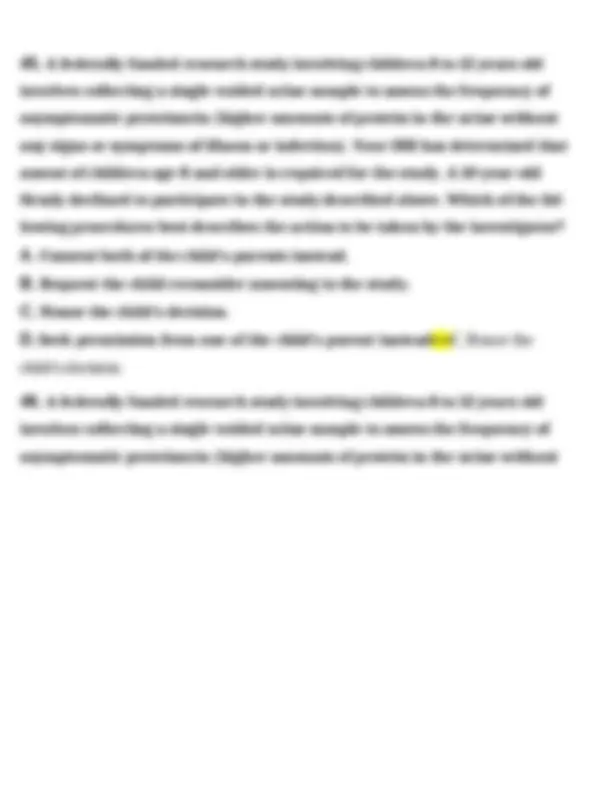
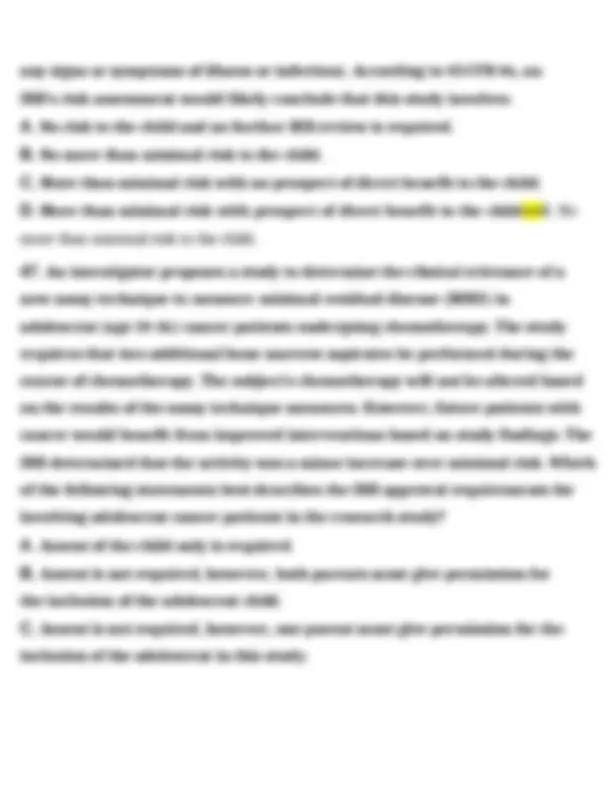
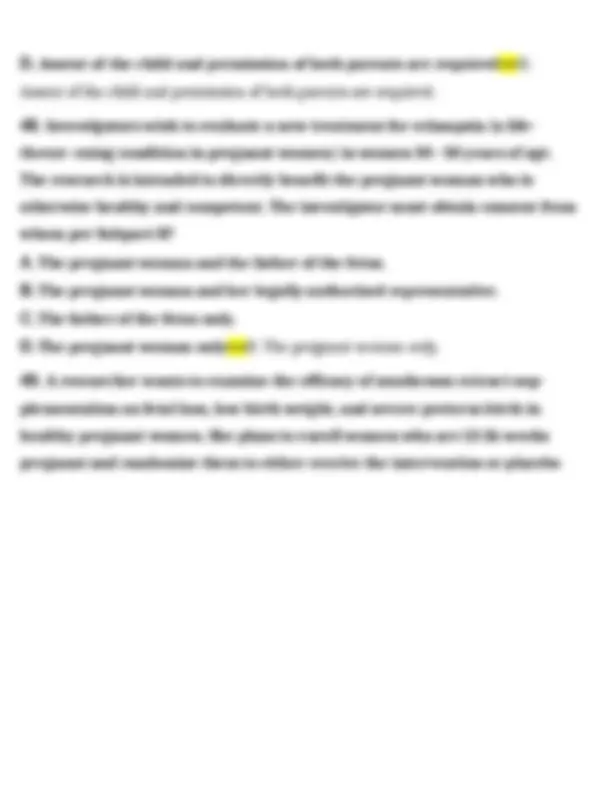
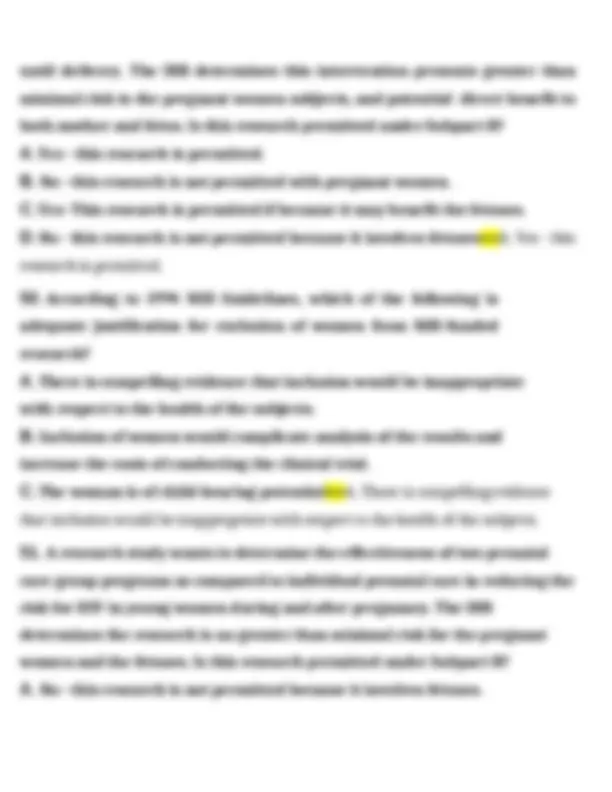
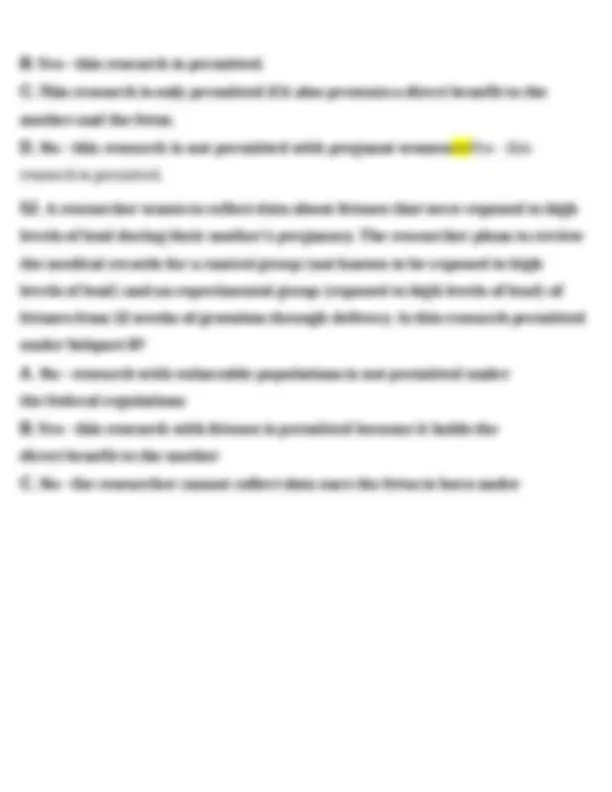
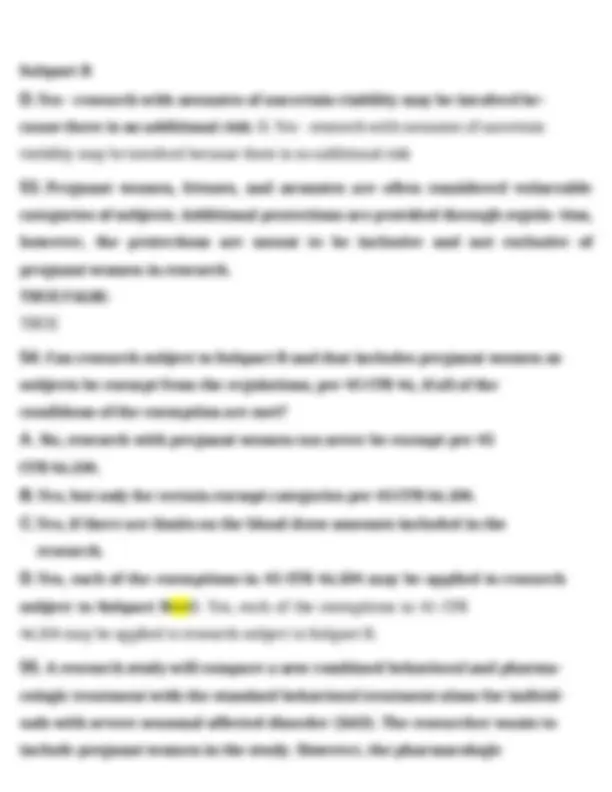

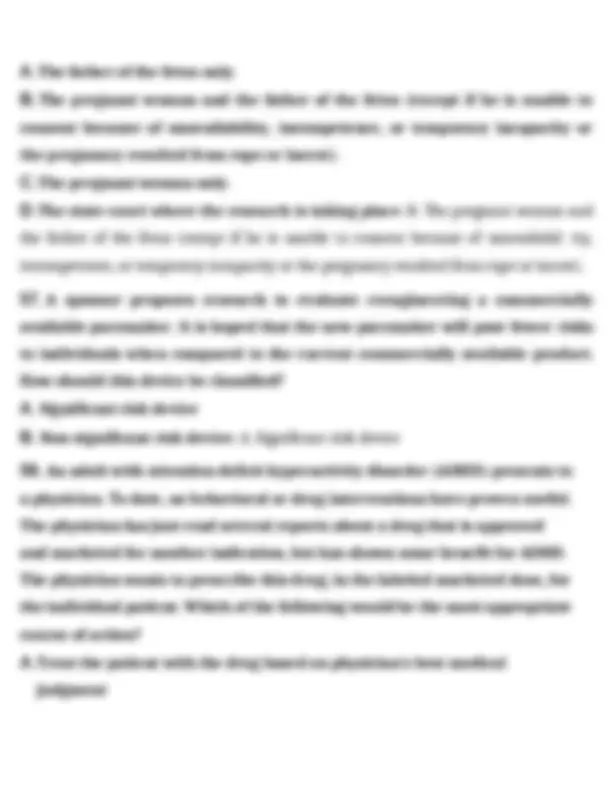
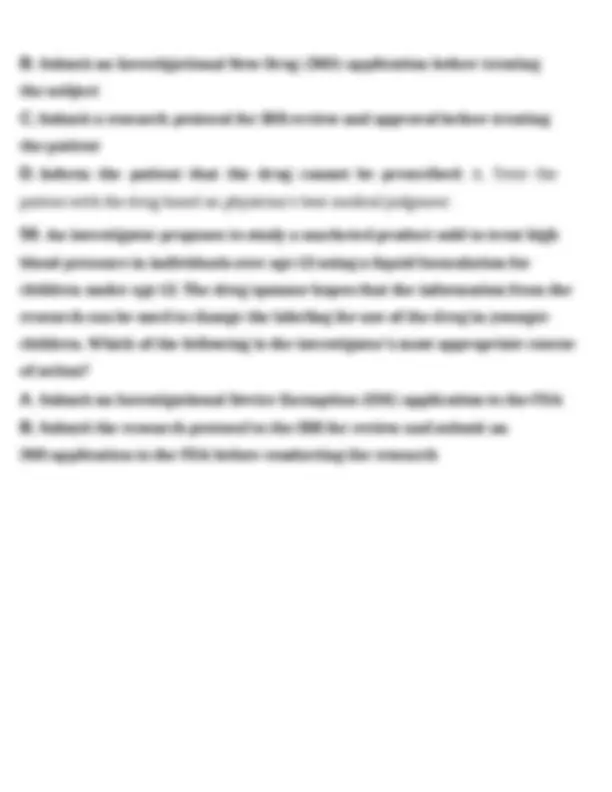
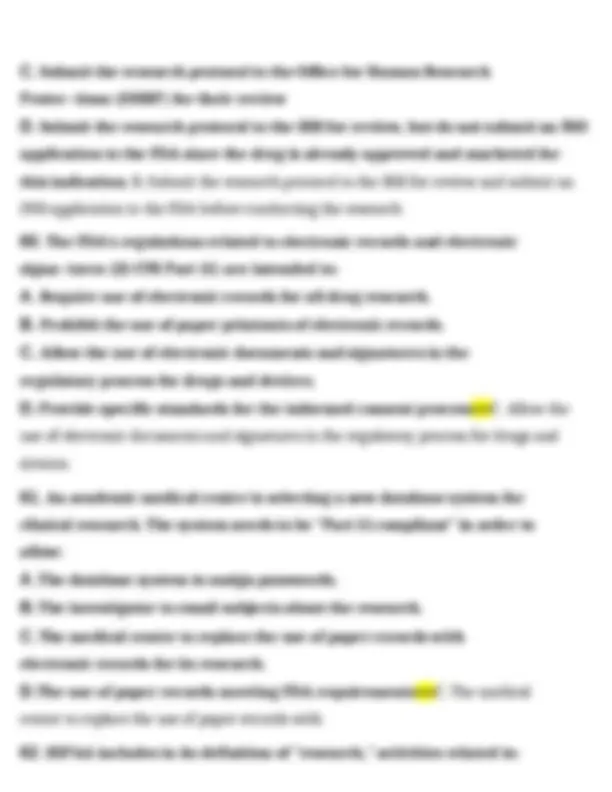
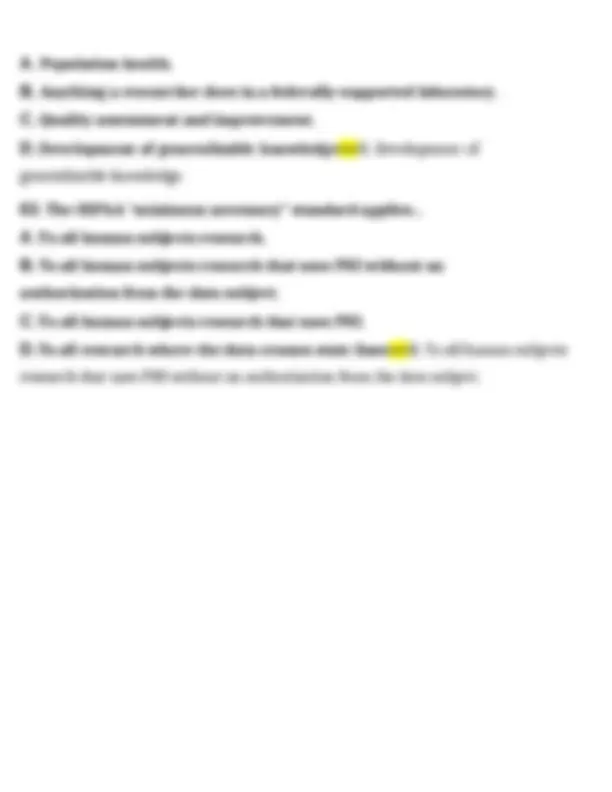
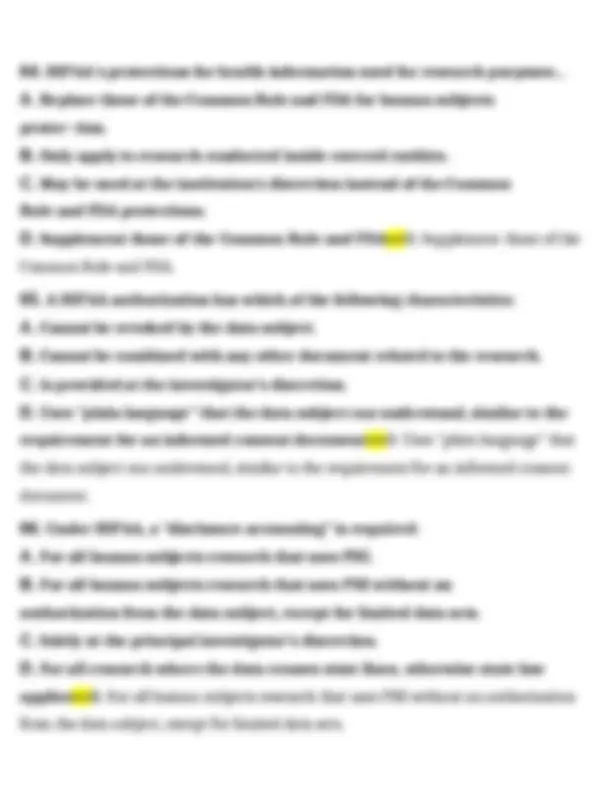
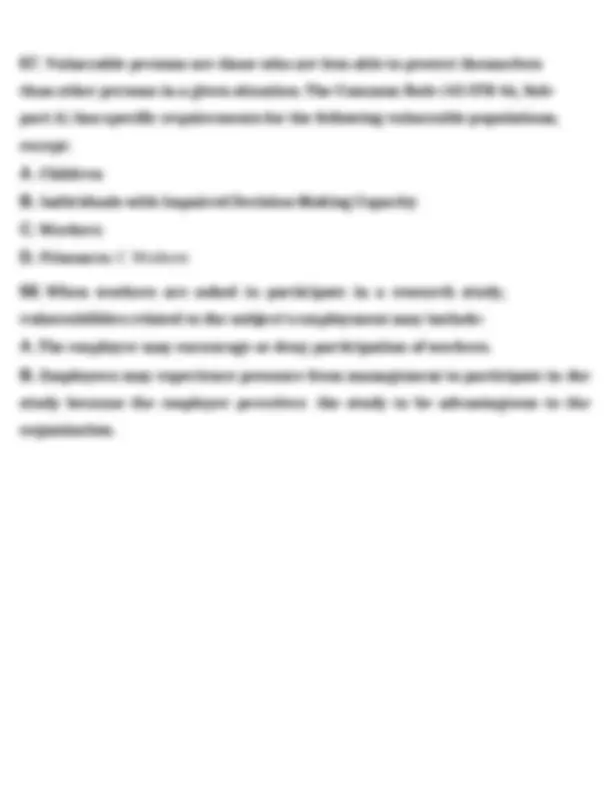
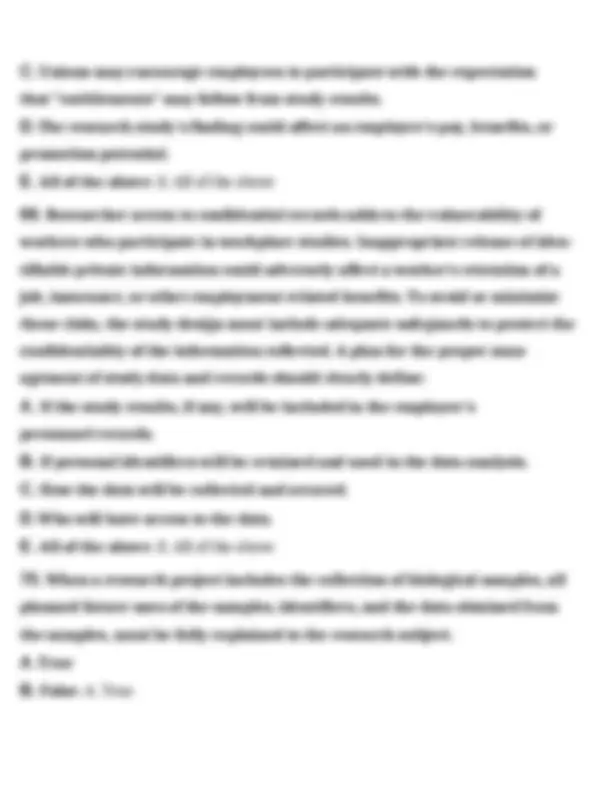
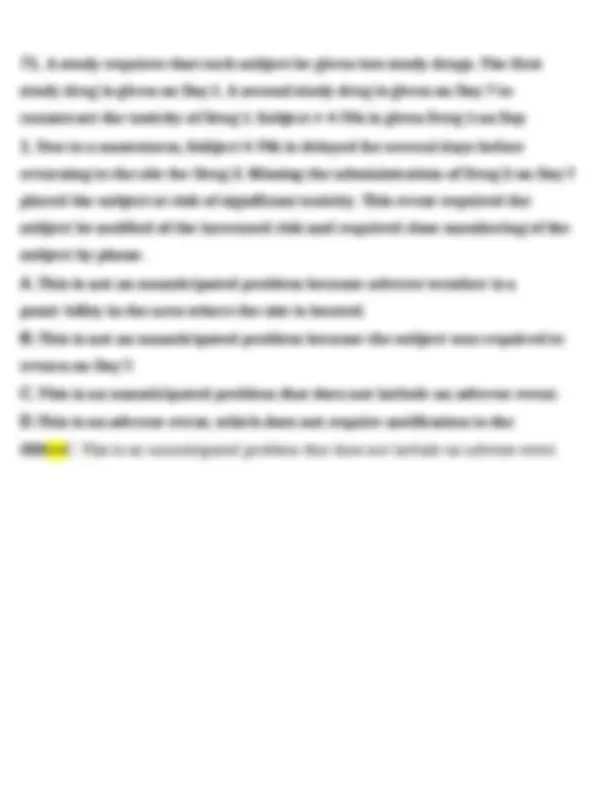
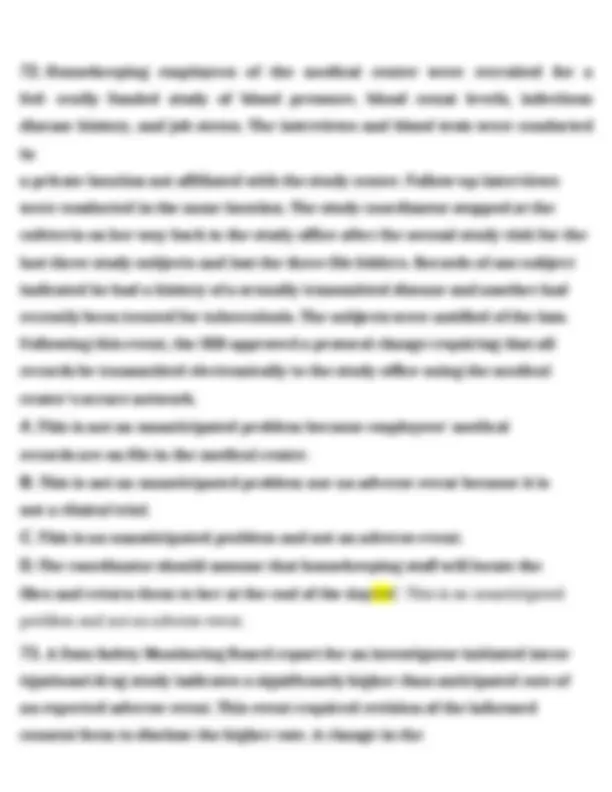
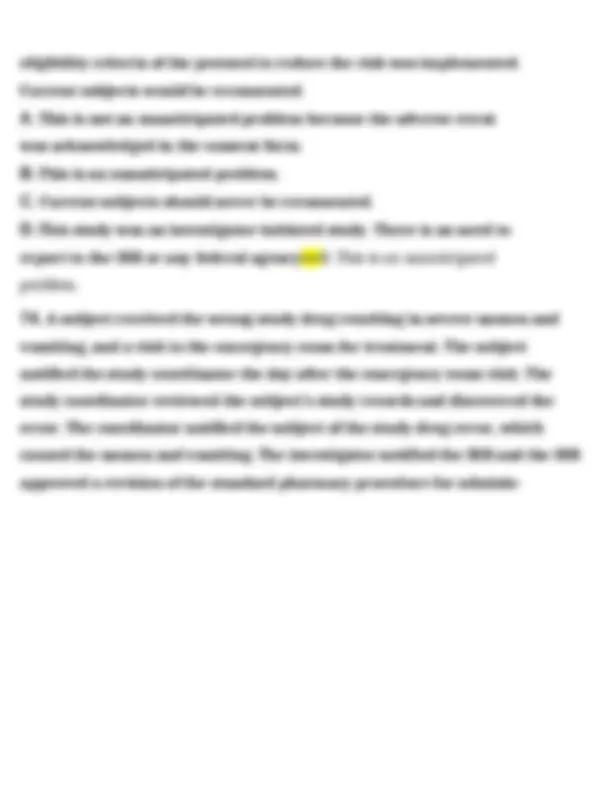
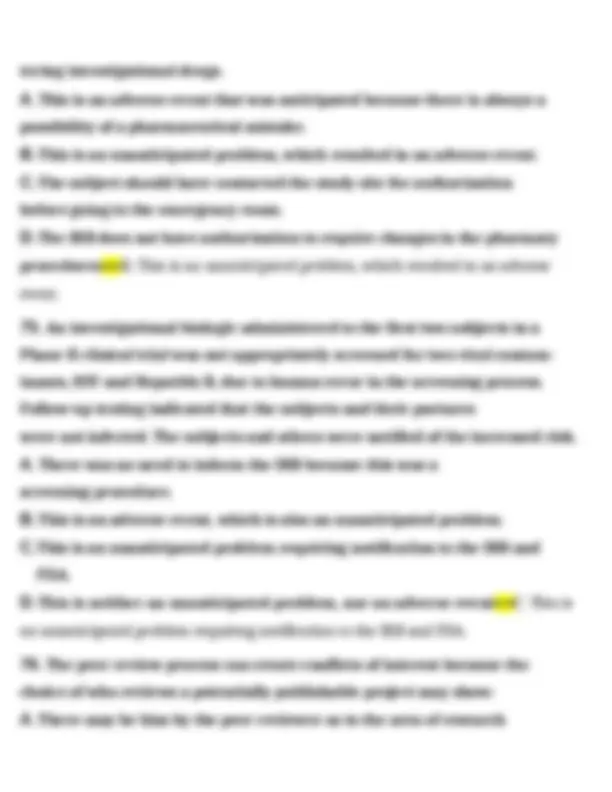
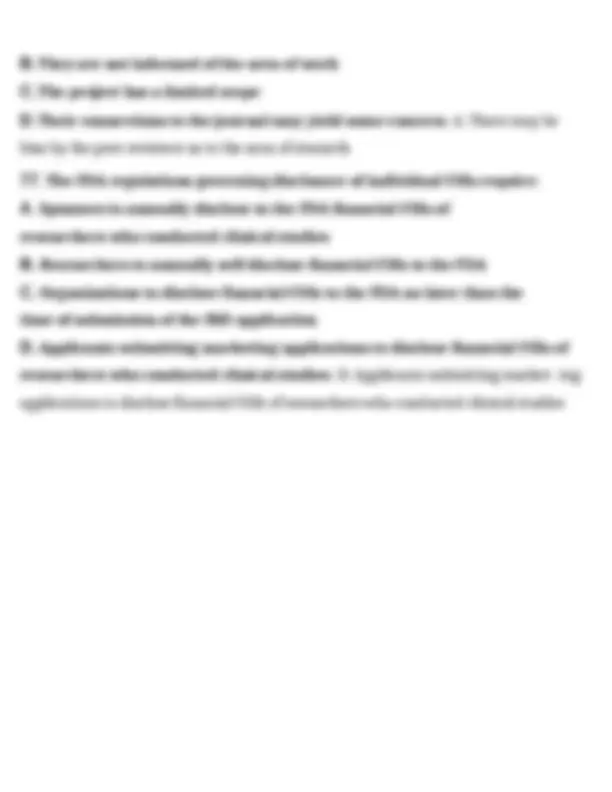
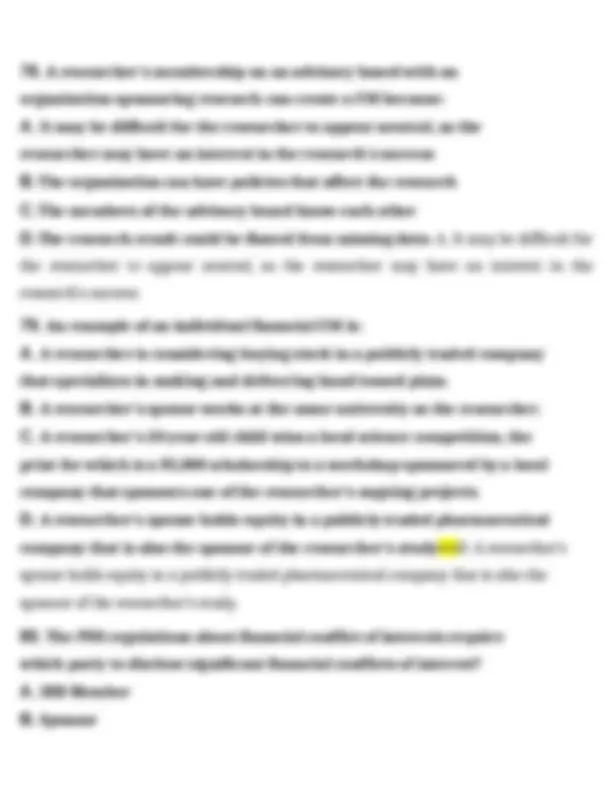
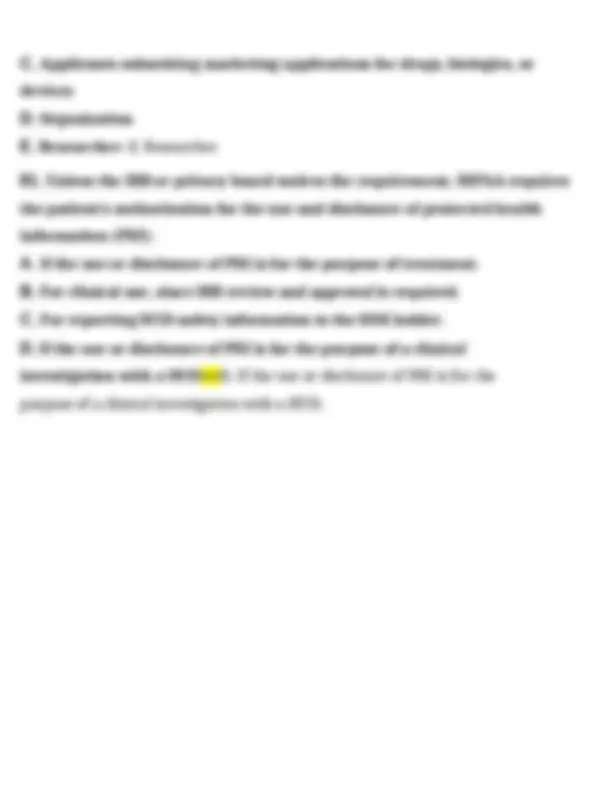
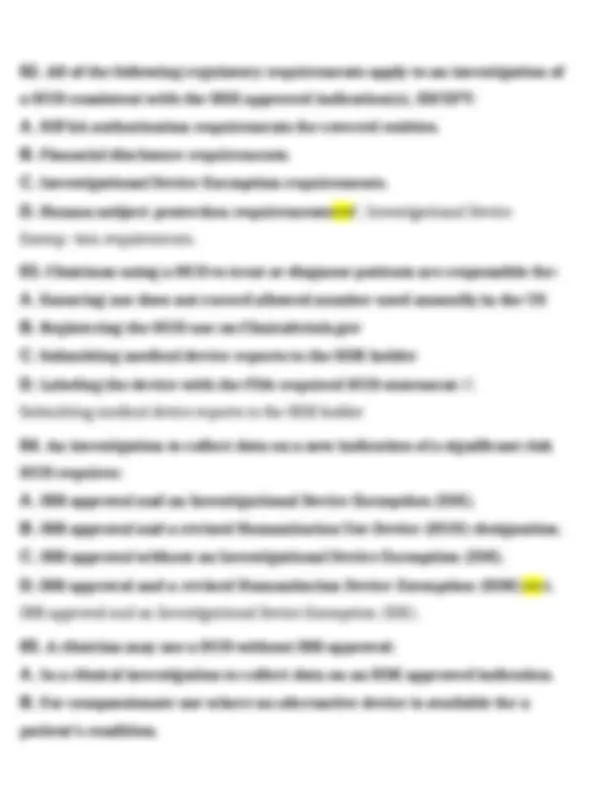
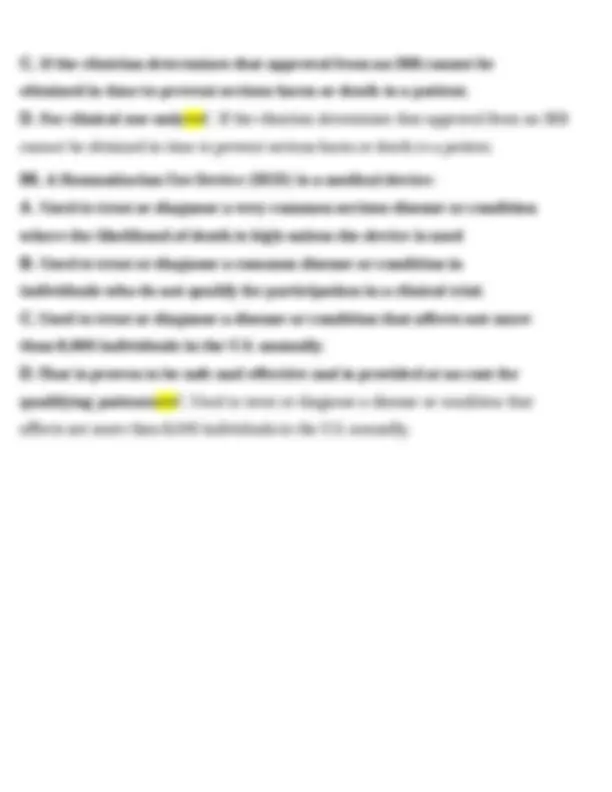
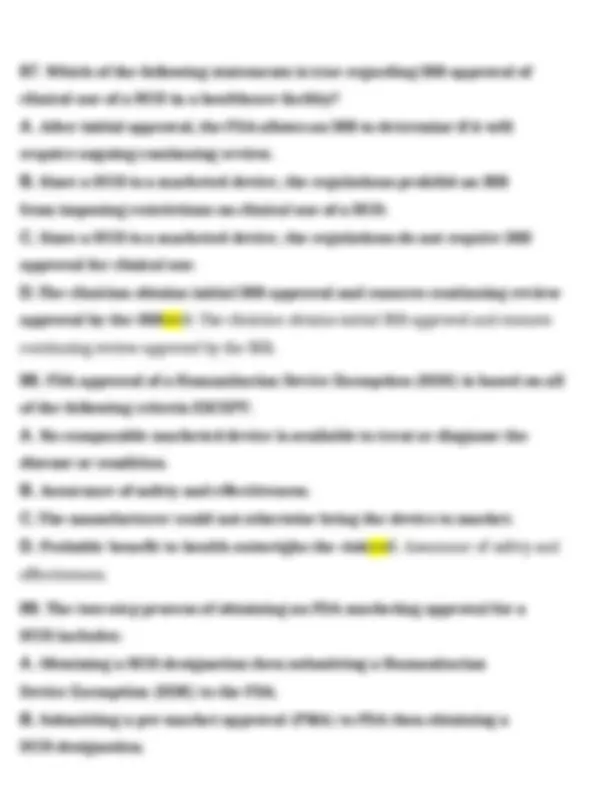
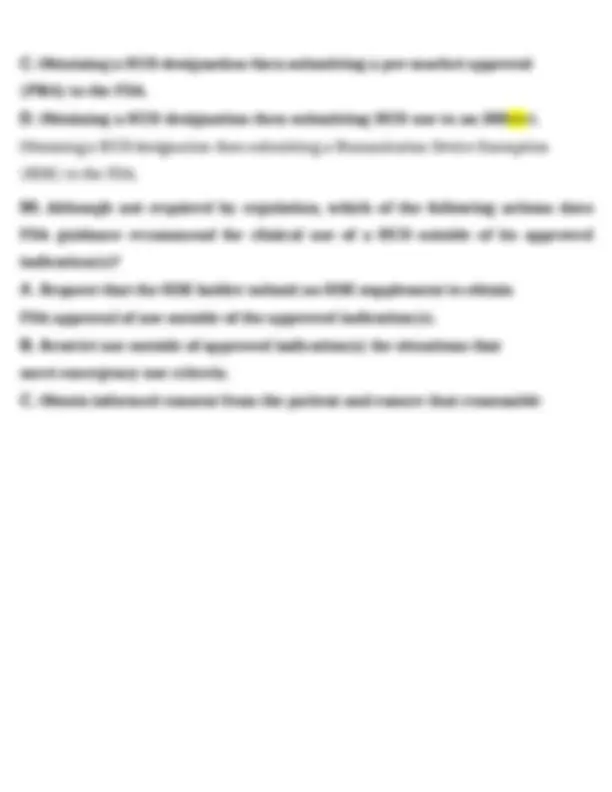
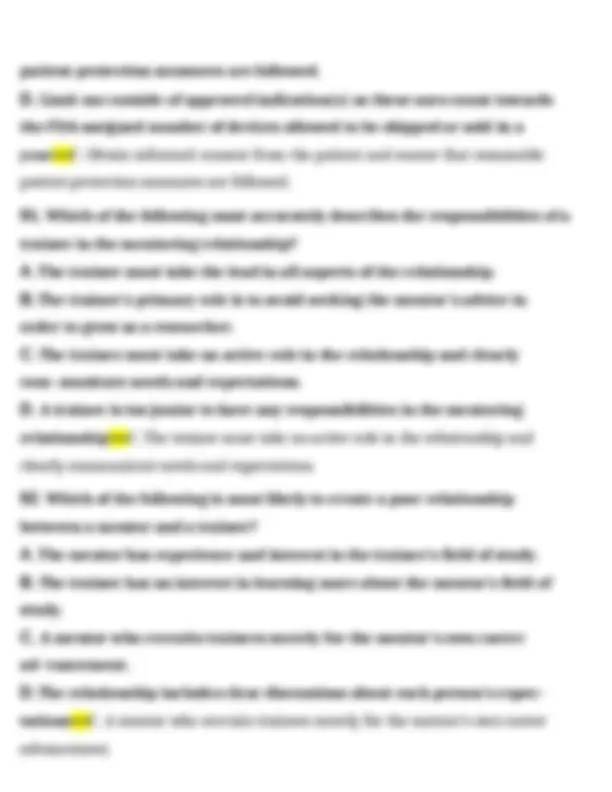
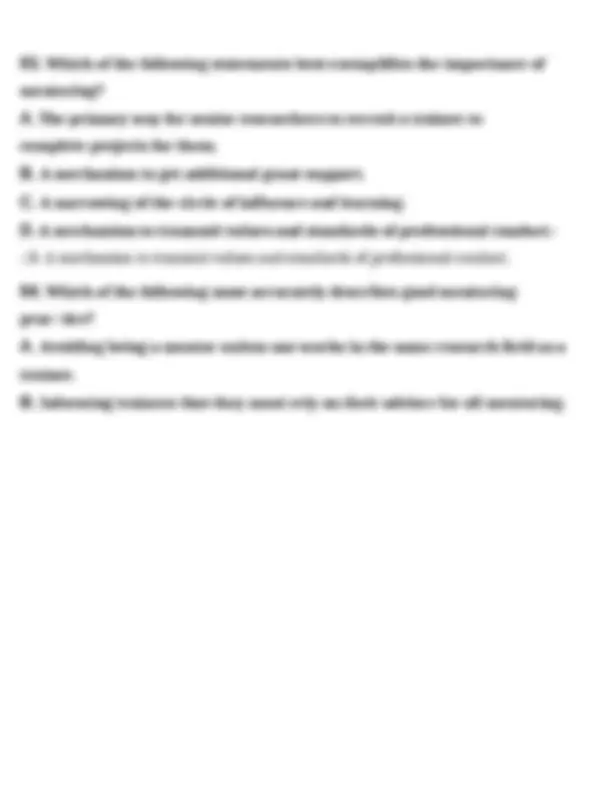
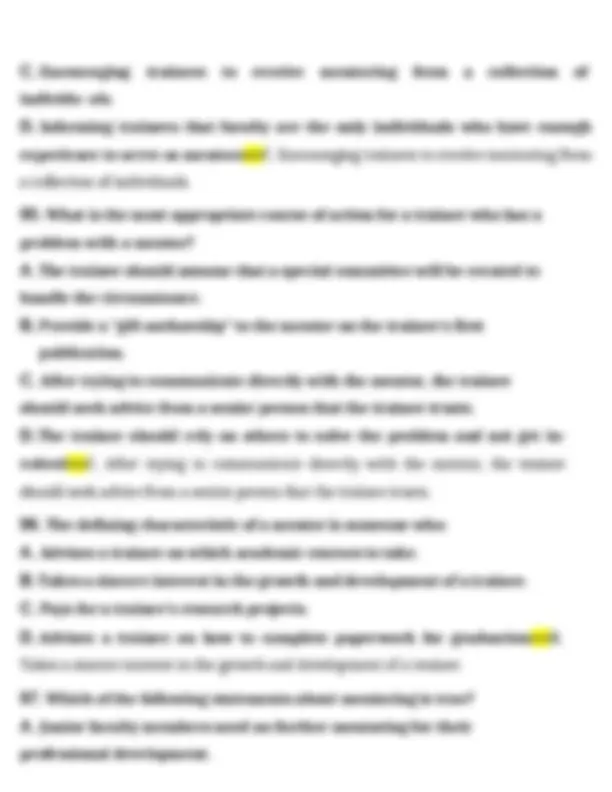
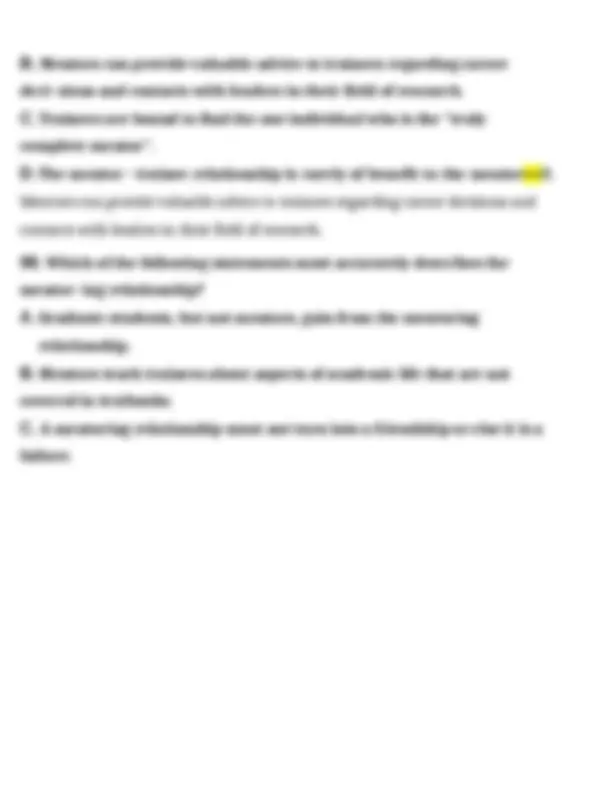
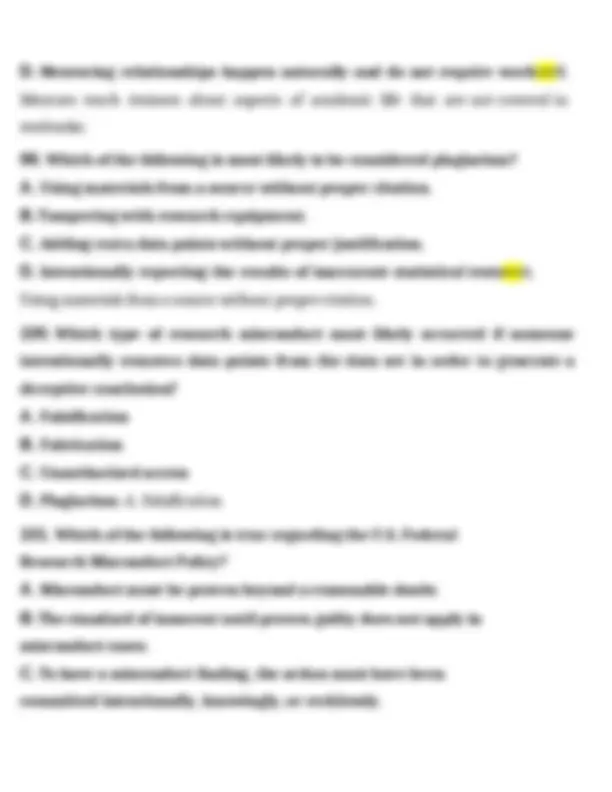
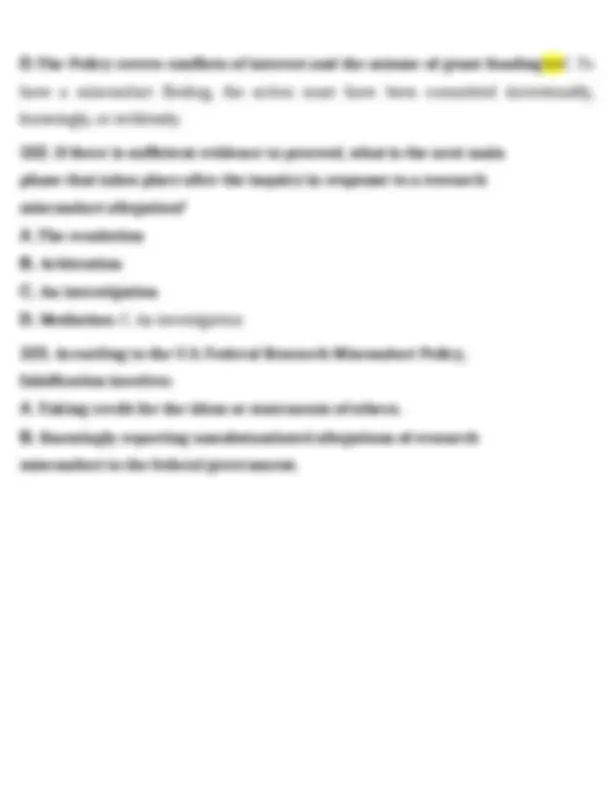
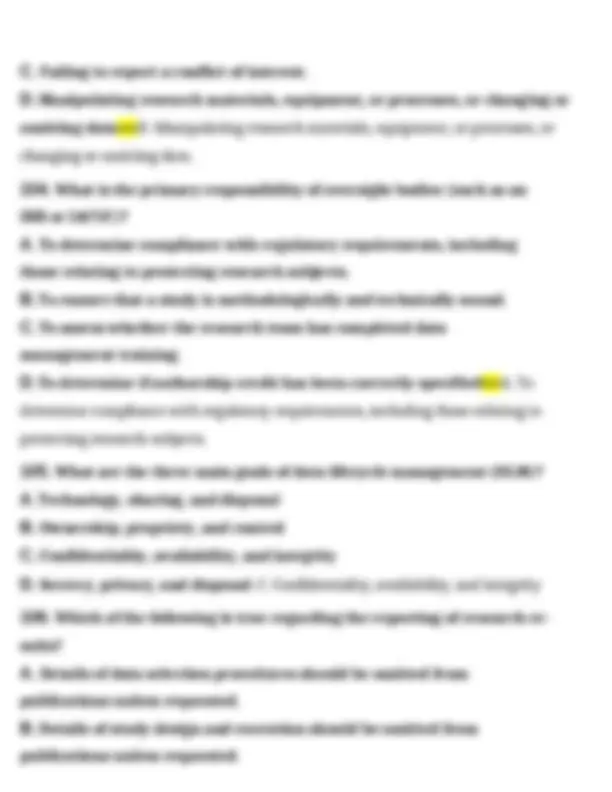
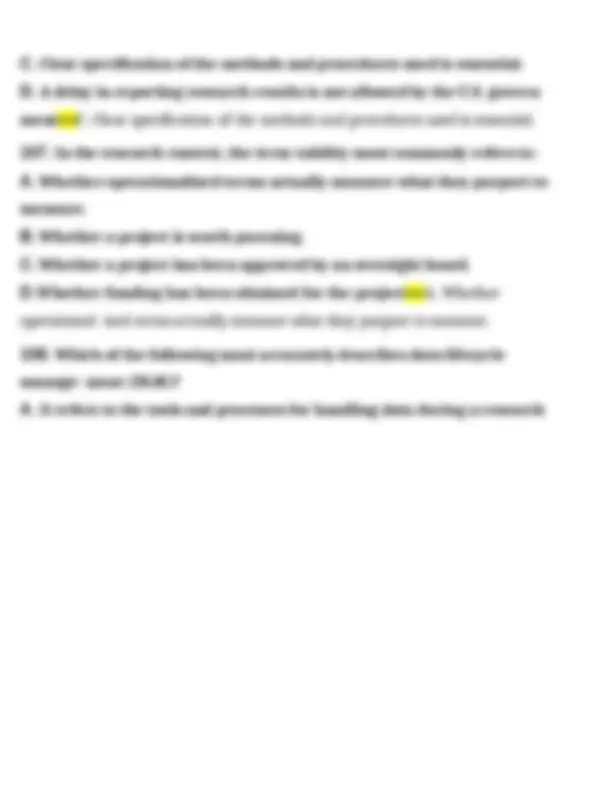
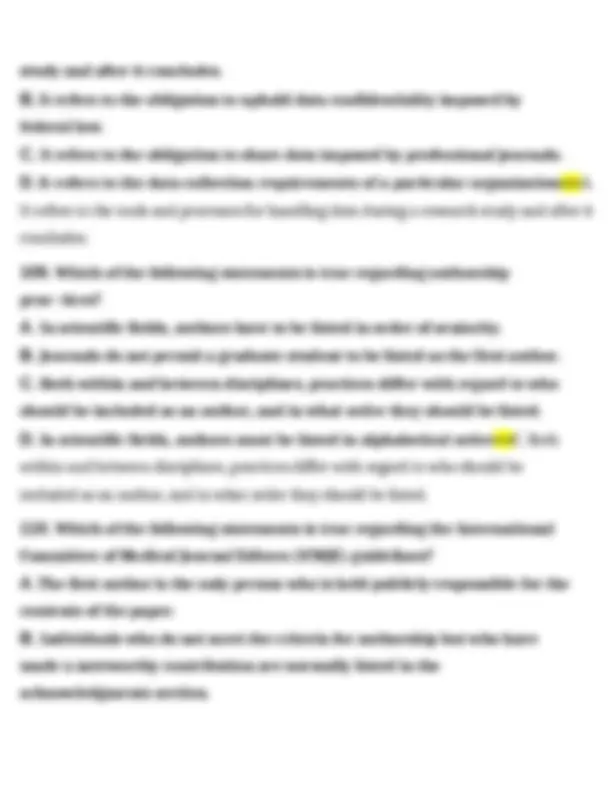
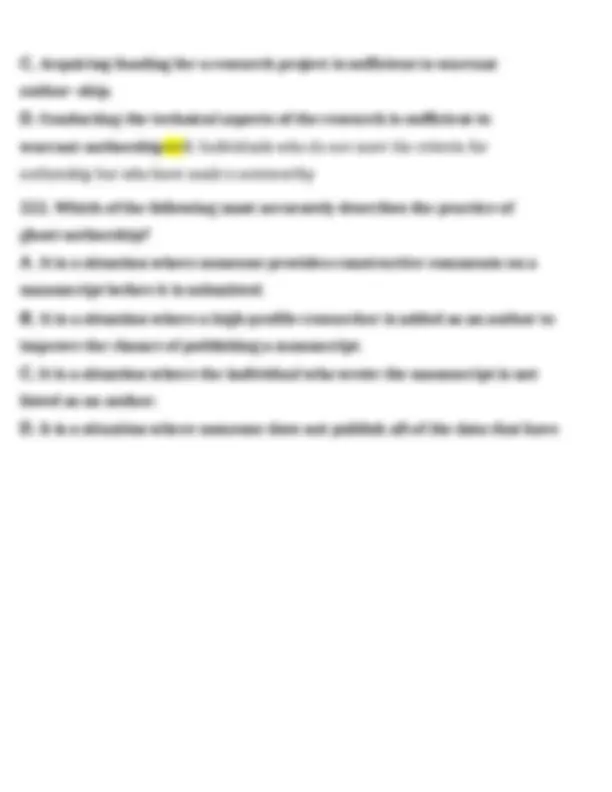
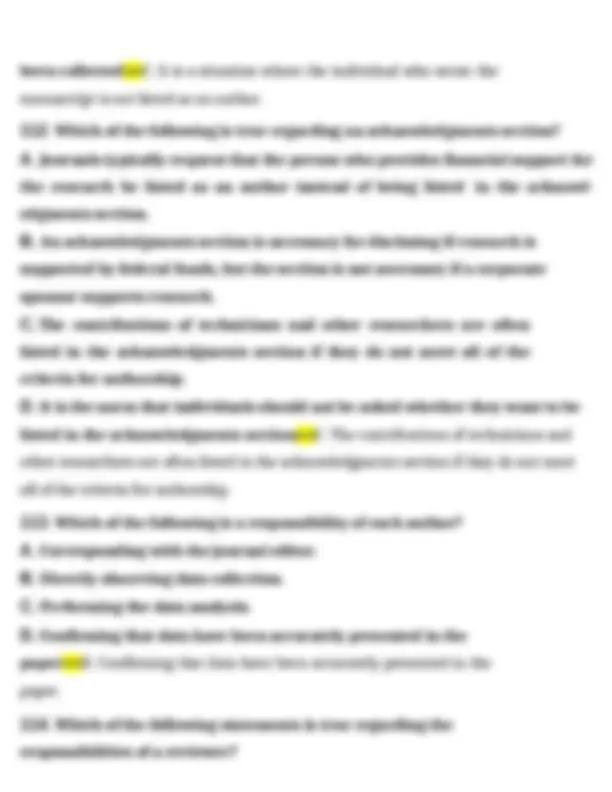
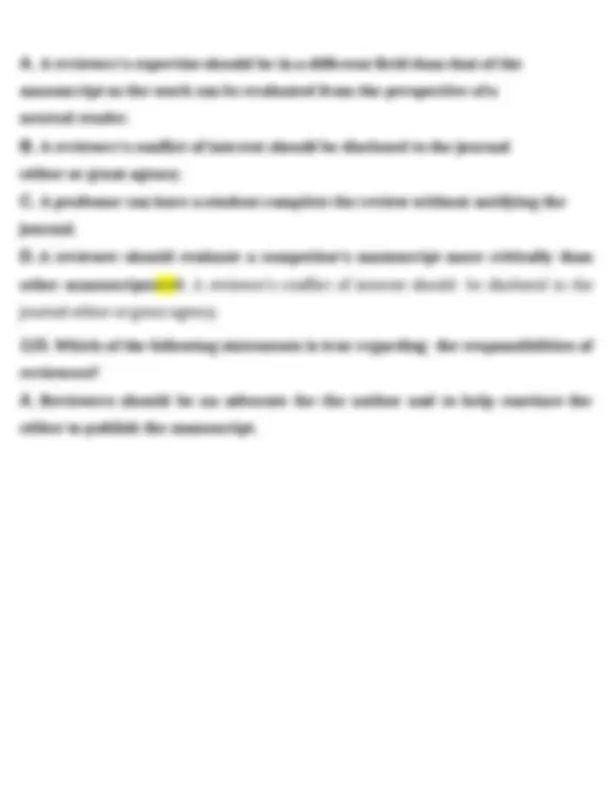
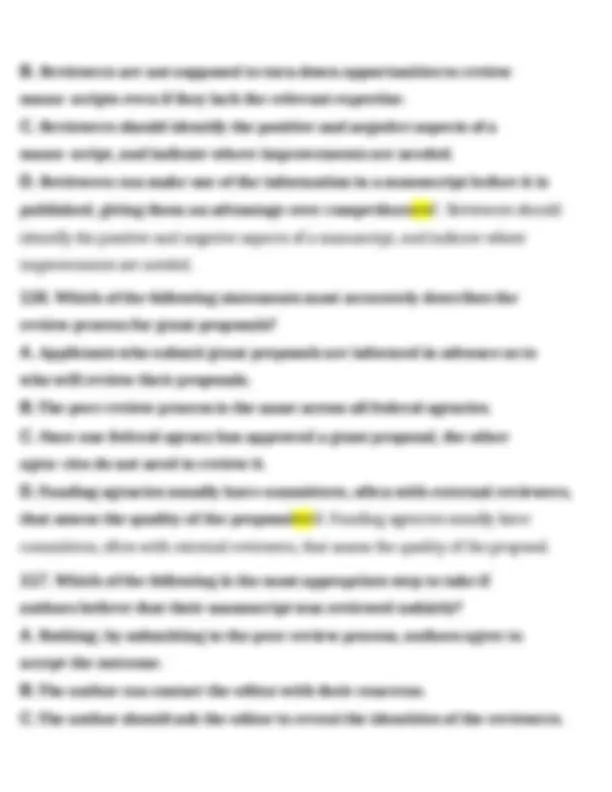

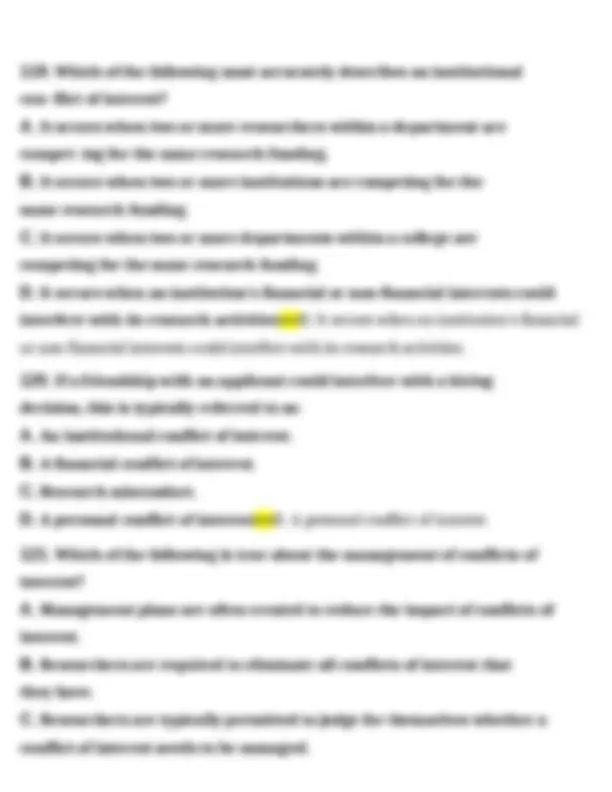
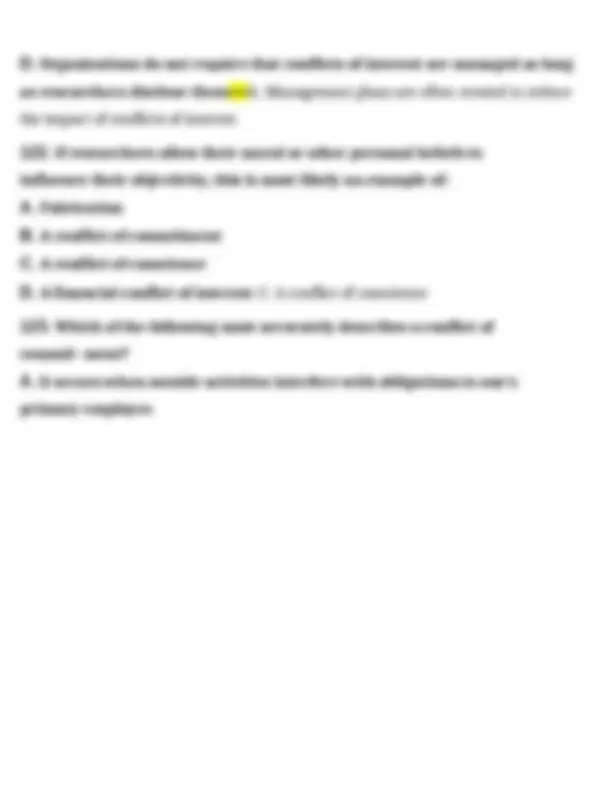

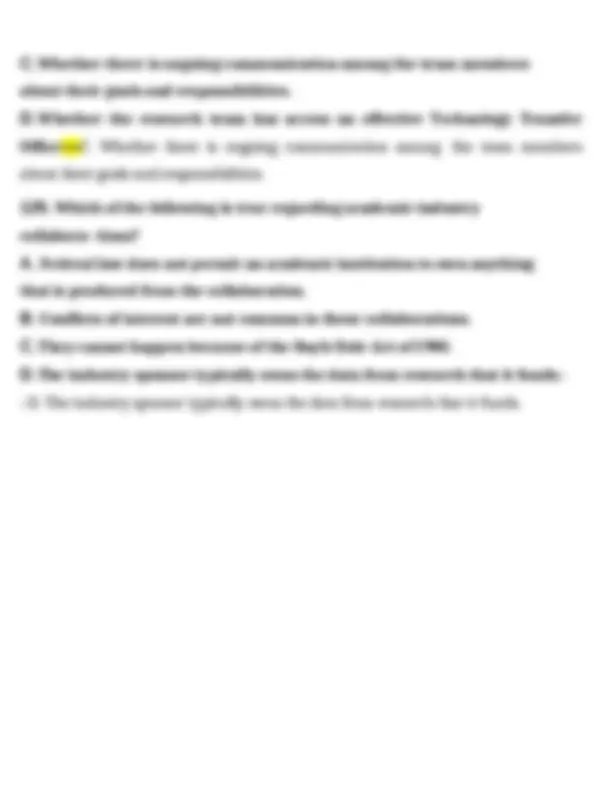
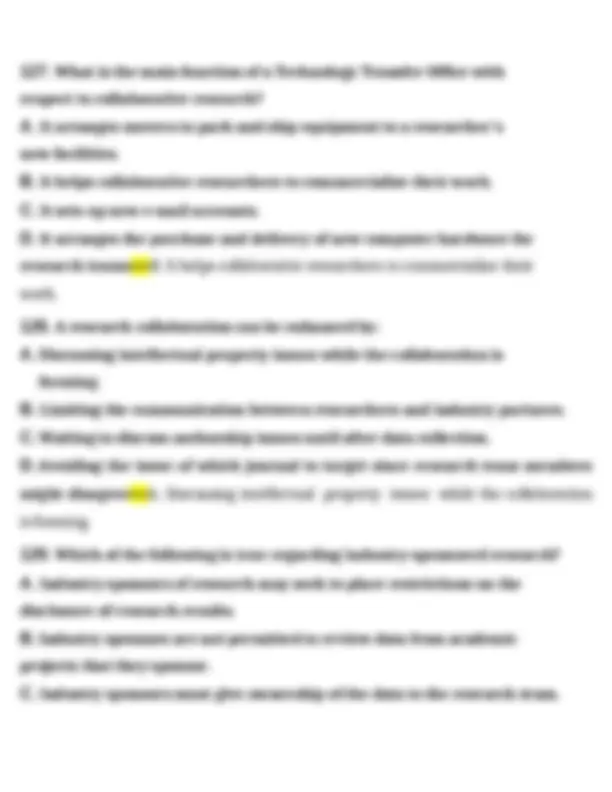

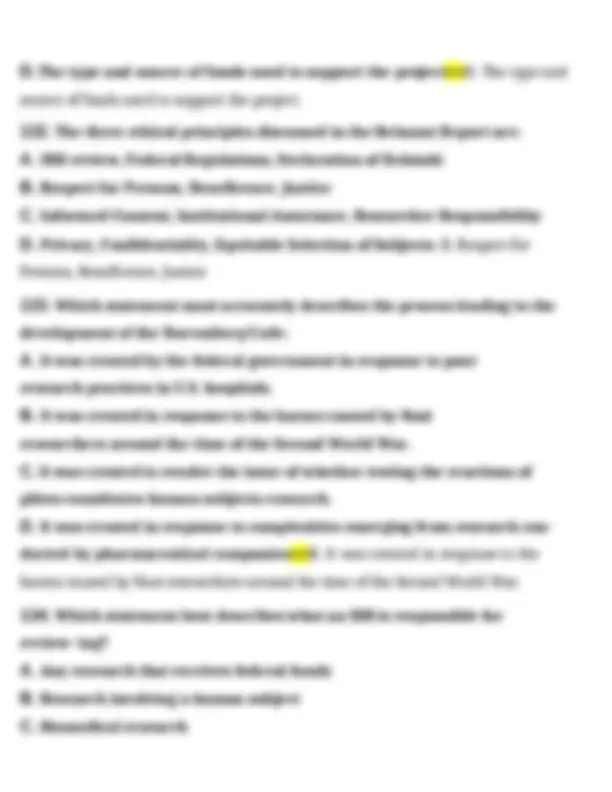
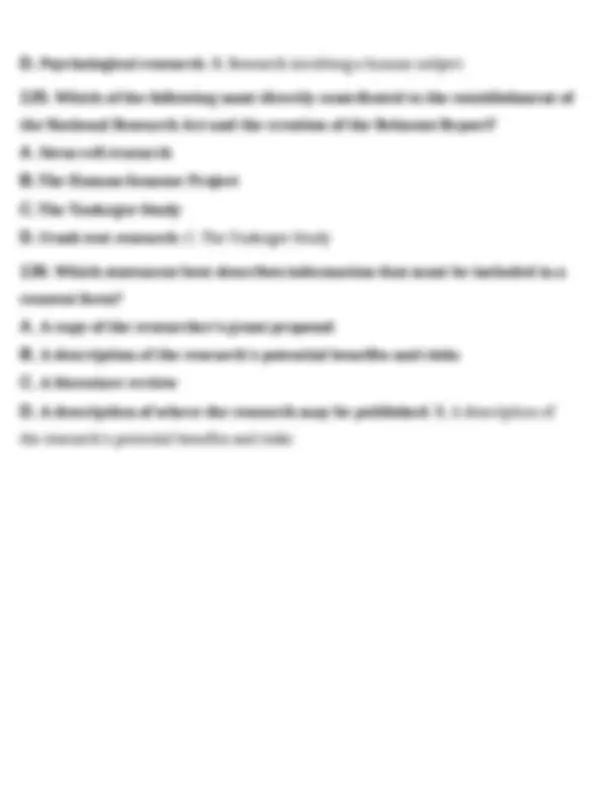



Study with the several resources on Docsity

Earn points by helping other students or get them with a premium plan


Prepare for your exams
Study with the several resources on Docsity

Earn points to download
Earn points by helping other students or get them with a premium plan
Community
Ask the community for help and clear up your study doubts
Discover the best universities in your country according to Docsity users
Free resources
Download our free guides on studying techniques, anxiety management strategies, and thesis advice from Docsity tutors
1. The Belmont Report's principle of respect for persons incorporates at least two ethical convictions: first, that individuals should be treated as autonomous agents, and second, that: A. Persons with diminished autonomy should only participate in no more than minimal risk research. B. Persons with diminished autonomy should be excluded from research. C. Persons with diminished autonomy are entitled to protection. D. Persons involved in research cannot financially benefit>>C. Persons with diminished autonomy are entitled to protection
Typology: Exams
1 / 71

This page cannot be seen from the preview
Don't miss anything!
































































1 /
1. The Belmont Report's principle of respect for persons incorporates at least two ethical convictions: first, that individuals should be treated as autonomous agents, and second, that: A. Persons with diminished autonomy should only participate in no more than minimal risk research. B. Persons with diminished autonomy should be excluded from research. C. Persons with diminished autonomy are entitled to protection. D. Persons involved in research cannot financially benefit>>C. Persons with diminished autonomy are entitled to protection. 2. Which of the following is an example of how the principle of beneficence can be applied to a study employing human subjects? A. Ensuring that persons with diminished autonomy are protected. B. Providing detailed information about the study and obtaining the subject's consent to participate. C. Determining that the study has a maximization of benefits and a minimiza- tion of risks. D. Ensuring that the selection of subjects includes people from all segments of the population>>C. Determining that the study has a maximization of benefits and a minimization of risks.
2 /
3. Which of the following are the three principles discussed in the Belmont Report? A. IRB Review, Federal Regulations, Declaration of Helsinki B. Privacy, Confidentiality, Equitable Selection of Subjects C. Informed Consent, Institutional Assurance, Researcher Responsibility D. Respect for Persons, Beneficence, Justice: D. Respect for Persons, Benefi- cence, Justice 4. When an IRB is reviewing a research study and they are considering if a potential subject population is vulnerable, they should consider: A. Are there adequate resources to conduct the study? B. Is there a power differential between researchers and subjects? C. Has the researcher completed required training? D. Are the research procedures greater than minimal risk of harm?: B. Is there a power differential between researchers and subjects? 5. Which is an example of a situation where deferential vulnerability might be a factor? A. An army medical officer recruiting subjects among lower ranks B. A college professor recruiting among their students C. A physician recruiting patients to be subjects
B. Cognitive or communicative vulnerability C. Physical vulnerability D. Economic or social vulnerability: B. Cognitive or communicative vulnerability
9. The use of prisoners in research is a concern under the Belmont principle of Justice because: A. Prisoners are less educated that the general population and have difficulty understanding research B. Prisoners may not be used to conduct research that only benefits the larger society C. Prisoners are not a representative sample of the general population D. Prisoners are not free to say no: B. Prisoners may not be used to conduct research that only benefits the larger society 10. Which of the following is included in the Nuremberg Code: A. Additional protection for vulnerable subjects B. Equitable selection of subjects
C. Confidentiality of data D. Voluntary consent: D. Voluntary consent
11. Which of the following brought increased public attention to the problems with the IRB system? A. 1983 Presidential Commission Report B. HHS Inspector General Report of 1998 C. "Shut Downs" by OHRP D. Death of Research Subject (Jesse Gelsinger): D. Death of Research Subject (Jesse Gelsinger) 12. Informed consent is considered an application of which Belmont princi- ple? A. Non-maleficence B. Justice C. Beneficence D. Respect for Persons: D. Respect for Persons 13. The National Research Act of 1974 A. Required that all federal agencies have the same regulations governing human subjects research. B. Identified guidelines to ensure the ethical conduct of research. C. Established the National Commission. D. Identified the basic ethical principles of human subjects research>>C. Established the National Commission. 14. A subject in a clinical research trial experiences a serious, unanticipated adverse drug experience. How should the investigator
A. As long as the investigator is at that institution B. For a minimum of three years after completion of the study C. Until data analysis is complete D. Until the study is closed: B. For a minimum of three years after completion of the study
16. According to federal regulations, which of the following best describes when expedited review of a new, proposed study may be used by the IRB? A. The study is required for a student research project B. The study includes only research subjects that are healthy volunteers. C. The study does not require informed consent or survey instruments. D. The study involves no more than minimal risk and meets one of the allowable categories of expedited review specified in federal regulations: D. The study involves no more than minimal risk and meets one of the allowable categories of expedited review specified in federal regulations 17. Amendments involving changes to IRB-approved protocols do NOT need prior IRB approval if: A. They only involve changes to the consent form. B. The changes must be immediately implemented for the health and well- be- ing of the subject. C. They are eligible for review using expedited procedures. D. The investigator keeps careful records of all changes and includes them in the final report>>B. The changes must be immediately implemented for the health and well-being of the subject.
18. IRB continuing review of a greater than minimal risk approved protocol that is currently enrolling subjects must: A. Include copies of all signed consent forms. B. Occur at least annually. C. Be conducted by an expedited review. D. Occur only when the level of risk changes>>B. Occur at least annually. 19. A general requirement for the informed consent form is that it may not in- clude any exculpatory language. Exculpatory language is that which waives or appears to waive any of the subject's legal rights or releases or appears to release those conducting the research from liability for negligence. Which of the following statements in a consent form is an example of exculpatory language? A. In the event of any injury you may have related to this research, you will be given medical treatment. B. Your participation in this research is voluntary. If you choose not to
informed consent can be made under these circumstances. The IRB will be notified later. D. Do not use the test article until either the subject or the subject's LAR can give consent>>C. The investigator and an independent physician agree that the situation necessitates the use of the test article. An exception or waiver for informed consent can be made under these circumstances. The IRB will be notified later.
21. An elderly gentleman, whose wife is his legally authorized representative (LAR) since his strokes several years ago, was recently diagnosed with lung cancer. He is eligible for a clinical trial using a new investigational drug that aims to treat lung cancer. He is able to express interest, shows a basic understanding of the nature of the trial, and gives his assent to participation. The subject's wife is out of town on a business trip. Which of the following is the most appropriate action to take for the investi- gator? A. Send a copy of the informed consent via facsimile to the subject's wife. After she has had the opportunity to speak to the investigator, she can sign the informed consent and fax it back. B. Exclude the man from the study.
C. Consult a colleague about his opinion. If the colleague agrees, enroll the man without a signed consent. D. The investigator can go ahead and enroll the man without a signed con- sent>>A. Send a copy of the informed consent via facsimile to the subject's wife. After she has had the opportunity to speak to the investigator, she can sign the informed consent and fax it back.
22. The purpose of informed consent is: A. To provide a potential subject with appropriate information in an appro- priate manner and allow that person to make an informed decision about participation in research. B. To obtain a signature from a study subject in order to protect the investi- gator, the study staff and the institution. C. To obtain a signature from a study subject in order to document his or her agreement to participate in research. D. To document the investigator's participation in the consent process>>A. To provide a potential subject with appropriate information in an appropriate manner and allow that person to make an informed decision about participation in research. 23. A 46-year-old man is currently enrolled in a Phase 2 study of a drug for severe diabetic neuropathy. While the study is on-going, a new drug becomes commercially available that may have equal or greater benefit to the subject. The investigator should do which of the following? A. Do not tell the subject about the new drug because physicians have the right to try out new treatments with their patients.
other information) and subjects may complete the survey and place it in a box at the shopping mall exits. Which of the following is the most important issue that the researcher addressed in planning the research? A. Possibility of emotional distress for subjects from the questions them- selves B. Data analysis from a large sample size C. Confidentiality of the individual subject's responses D. Recruitment of subjects to ensure varied characteristics of the sample size: C. Confidentiality of the individual subject's responses
25. A researcher wants to invite therapists to participate in small focus groups to discuss their perceptions regarding "troubled" adolescent girls and the relationships they have with their parents. Specific clients of the therapists will not be discussed. Which of the following will be the most important issue for the researcher to consider when planning the research? A. Amount of compensation for the subject's (therapist's) time B. Emotional distress from discussing the topic C. Recruiting strategies to ensure quick enrollment and completion of the research D. Breach of confidentiality from the focus group subjects (therapists): D. Breach of confidentiality from the focus group subjects (therapists) 26. Which of the following most accurately describes the risks associated with SBR? A. Less predictable, more variable, and less treatable than physical harms B. More likely to be treatable by researchers than physical harms
C. Less serious and more frequent than physical harms D. Shorter in duration and less frequent than physical harms: A. Less pre- dictable, more variable, and less treatable than physical harms
27. Which of the following is considered a SBR data collection method? A. Blood draws B. Interviews C. Hearing/audiological screenings D. Physical exams: B. Interviews 28. An investigator obtains consent and HIPAA authorization from subjects to review their medical records and HIV status. He plans to go back to the medical record, so the HIV status information is stored along with subject identifiers in a database that he keeps on his laptop computer. His laptop is stolen. This incident constitutes: A. A FERPA violation
C. The research could not practicably be carried out without the waiver of consent. D. The research plan includes data from individuals no longer living>>C. The research could not practicably be carried out without the waiver of consent.
31. Investigator A has biological specimens that are coded and linked to identifiers of the source individuals. Investigator A provides the specimens to Investigator B but does not provide the individual identifiers. Investigator B agrees not to re-identify the source individuals. Is Investigator B's research using the biospecimens human subjects research according to the definition of human subjects research in the federal regulations? A. Yes, because Investigator A retains the identifiers and therefore the spec- imens are identifiable. B. No, because Investigator B cannot readily ascertain the identity of the specimen sources. C. Yes, because the specimens are from human subjects.
D. No, because Investigator B cannot readily ascertain the identity of the source individual and Investigator B has agreed not to attempt re- identifica- tion. E. No, because Investigator B's research does not involve interaction with humans>>D. No, because Investigator B cannot readily ascertain the identity of the source individual and Investigator B has agreed not to attempt re- identification.
32. Which of the following statements is accurate in determining subject risk involved in a genetic study: A. Understanding the risks involved in other genetic studies is critical in determining the risk involved in a new study B. All genetic studies should be considered greater than minimal risk C. All genetic studies should be considered no more than minimal risk D. Understanding the purpose and context of a specific study is critical in determining the risk involved: D. Understanding the purpose and context of a specific study is critical in determining the risk involved 33. Under which of the following conditions is it appropriate to re-contact the individuals who provided biological specimens? A. Subjects received financial compensation for participation in the study B. Original signed consent documents include provisions for recontacting subjects C. Discovery of related clinical information requires contacting subjects for follow-up D. Biological specimens need to be replenished: B. Original signed consent documents include provisions for recontacting subjects
for research on lung cancer. Can Investigator B use the specimens for cancer research without re-consent if the specimens are de-identified? A. No, because it would be unethical to conduct research that is not consis- tent with the consent form the subjects originally signed. B. Yes, if the biospecimens are de-identified then the research is no longer considered human subjects research. C. Yes, because research with biospecimens is minimal risk. D. No, the original research subjects must be re-consented for the cancer research>>B. Yes, if the biospecimens are de-identified then the research is no longer considered human subjects research.
36. Which choice is the best definition of "genetic determinism?" A. Genetic information about an individual can foster stigma and discrimina- tion B. Genetic testing can determine appropriate treatments for certain health conditions C. Parents determine the nature of their children through the inheritance of genes D. Genes are primarily responsible for human traits, including health, behav- ior, and disease: D. Genes are primarily responsible for human traits, including health, behavior, and disease 37. Which choice best describes the purpose of most pharmacogenomic research? A. To evaluate whether genetic testing can reduce the cost of pharmaceuti- cals
B. To evaluate the association between individual genotypes and the safety and efficacy of a particular drug or class of drugs C. To evaluate how the genomes of infectious agents impact the efficacy of certain antibiotics D. To evaluate how different racial and ethnic groups respond to certain drugs or classes of drugs: B. To evaluate the association between individual genotypes and the safety and efficacy of a particular drug or class of drugs
38. Under which of the following conditions is it appropriate to re-contact the individuals who provided biological specimens? A. Original signed consent documents include provisions for recontacting subjects B. Biological specimens need to be replenished C. Discovery of related clinical information requires contacting subjects for follow-up